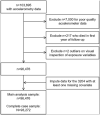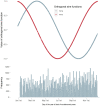Wearable-device-measured physical activity and future health risk
- PMID: 32807930
- PMCID: PMC7116559
- DOI: 10.1038/s41591-020-1012-3
Wearable-device-measured physical activity and future health risk
Abstract
Use of wearable devices that monitor physical activity is projected to increase more than fivefold per half-decade1. We investigated how device-based physical activity energy expenditure (PAEE) and different intensity profiles were associated with all-cause mortality. We used a network harmonization approach to map dominant-wrist acceleration to PAEE in 96,476 UK Biobank participants (mean age 62 years, 56% female). We also calculated the fraction of PAEE accumulated from moderate-to-vigorous-intensity physical activity (MVPA). Over the median 3.1-year follow-up period (302,526 person-years), 732 deaths were recorded. Higher PAEE was associated with a lower hazard of all-cause mortality for a constant fraction of MVPA (for example, 21% (95% confidence interval 4-35%) lower hazard for 20 versus 15 kJ kg-1 d-1 PAEE with 10% from MVPA). Similarly, a higher MVPA fraction was associated with a lower hazard when PAEE remained constant (for example, 30% (8-47%) lower hazard when 20% versus 10% of a fixed 15 kJ kg-1 d-1 PAEE volume was from MVPA). Our results show that higher volumes of PAEE are associated with reduced mortality rates, and achieving the same volume through higher-intensity activity is associated with greater reductions than through lower-intensity activity. The linkage of device-measured activity to energy expenditure creates a framework for using wearables for personalized prevention.
Conflict of interest statement
The authors declare no competing interests.
Figures










Comment in
-
Linking volume and intensity of physical activity to mortality.Nat Med. 2020 Sep;26(9):1332-1334. doi: 10.1038/s41591-020-1019-9. Nat Med. 2020. PMID: 32807932 No abstract available.
-
Device-measured physical activity and type 2 diabetes mellitus risk.Front Endocrinol (Lausanne). 2023 Dec 18;14:1275182. doi: 10.3389/fendo.2023.1275182. eCollection 2023. Front Endocrinol (Lausanne). 2023. PMID: 38179306 Free PMC article.
References
-
- Statista. Wearable Devices. 2019 < https://www.statista.com/study/15607/wearable-technology-statista-dossier/>.
-
- Pate RR, et al. Physical activity and public health. A recommendation from the Centers for Disease Control and Prevention and the American College of Sports Medicine. JAMA. 1995;273:402–407. - PubMed
-
- U.S. Department of Health and Human Services. U.S. Department of Health and Human Services; Washington, DC: 2008. - PubMed
-
- World Health Organization. World Health Organization; Geneva, Switzerland: 2010.

